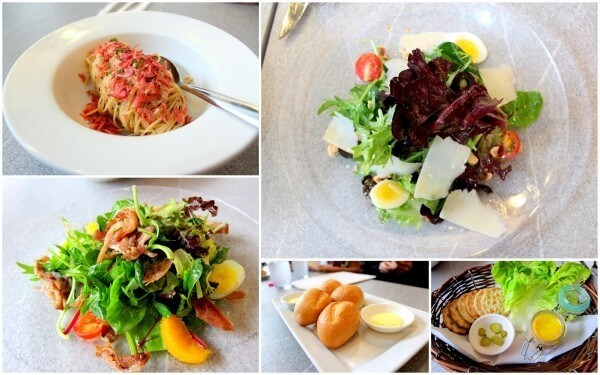SITHCCC006 Prepare appetisers and salads
Due to the repetition of many of the elements in the core cookery units we have combined eight (8) units of competency into an 11 chapter learner guide. The units included in this volume are;
- SITHCCC005 – Prepare dishes using basic methods of cookery
- SITHCCC006 – Prepare appetisers and salads
- SITHCCC007 – Prepare stocks, sauces and soups
- SITHCCC008 – Prepare vegetable, fruit, egg and farinaceous dishes
- SITHCCC012 – Prepare poultry dishes
- SITHCCC013 – Prepare seafood dishes
- SITHCCC014 – Prepare meat dishes
- SITHCCC019 – Produce cakes, pastries and breads
Learning outcomes
In this chapter / unit you will learn how to;
- Select ingredients for salads and appetisers
- Select, prepare and use equipment
- Prepare appetisers and salads
- Present and store appetisers and salads
as well as;
- Classifying salads and their ingredients
- Select and use relevant cookery methods for salads and appetisers
- Prepare sauces and dressings according to recipe
- Follow standard recipes and make food quality adjustments within scope of responsibility.
Introduction
A salad is generally accepted to be a cold (or possibly warm) dish of various mixtures of raw or cooked vegetables or herbs, seasoned with a dressing. A salad can have one main ingredient as the feature (e.g. potato salad), or a combination of ingredients and flavours (e.g. Greek salad). The food mixtures are either arranged on a plate, or tossed and served with a moist dressing.
With the warm temperatures experienced across Australia, salads have played, and will continue to play, an important role in culinary tastes. They also provide opportunities for a chef to be creative and imaginative.
Appetisers, on the other hand, can be hot or cold and their purpose is, as the name suggests; to stimulate a person’s appetite prior to a main meal being served.
Classifying Salads and their Ingredients
Salads are versatile and can be served as either:
- An appetiser
- Entrée
- Main course
- Dessert
- Snacks
- Accompaniments to a meal
- As part of a buffet
They can be:
- Cold or warm
- Raw, cooked, or a combination of raw and cooked
- Fruit only, vegetables only, or a combination
Salads can be classified according to the ingredients used:
- Simple salads – have one ingredient as the main feature; this may be a vegetable e.g. tomato, potato, leafy vegetable such as lettuce or even a fruit. A dressing is then added to add to the flavour and interest.
- Compound salad (also known as a mixed salad) – has two or more main ingredients and a dressing. Examples may include:
- Coleslaw (shredded cabbage, carrot, capsicum and coleslaw dressing)
- Rice salad (cooked cold rice, capsicum, celery, spring onion with a light vinaigrette)
- Classical salads – are based on traditional French Cuisine. Examples of these salads include:
- Salad Nicoise (French beans, boiled potatoes, tomatoes, anchovy, olives, capers and a French dressing)
- Salad Waldorf (celery, apple, chopped walnuts, mayonnaise and cream)
- Contemporary (modern) salads – this is a term to classify any contemporary developments in salads that may have an international twist. Modern styles of salads include:
- Thai beef salad
- Chicken Caesar salad
- Vietnamese prawn and mango salad
- Warm Duck breast salad
- Warm lamb salad
- Indonesian Gado Gado salad – cold vegetables and boiled egg drizzled with a warm peanut dressing
There is a vast array of ingredients that salads and appetisers can be made from. The multicultural influence on Australian cuisine increases the range of ingredients that can be used and broadly, these ingredients can be used from the following categories: … continued in learner guide….
Appetisers and Canapes
Appetisers are small portions of food served before a main meal (usually evening meals). As the wording implies, an appetiser stimulates the appetite and the palate. They are often served with pre-dinner drinks, as finger food and can be either hot or cold. They should be light, flavoursome, attractive and easily handled as finger food. In the traditional French menu, appetisers, also known as hors d’oeuvre, would be the first course on the menu.
Canapés are a form of appetiser. They can be served prior to lunch, dinner or at a drinks reception.
Canapés are small squares, rectangles, triangles or circles (carefully and neatly cut) of fried bread (croute-based), topped with flavoured butters and a variety of colourful but delicate foods, for example smoked salmon, caviar etc. Toppings are usually colourful and visually appealing. Loose items are secured by spreading a flavoured butter, mayonnaise, cream cheese or other paste/cream onto the base.
Whilst the traditional form of a canapé uses a crouton base of fried bread to make small bite size pieces of food, the contemporary canapé is more likely to be on a slightly larger toast or pastry base. Traditional canapés are very rich and quite greasy. In contemporary food service there is a distinct move away from greasy, fatty foods. They should also follow strict, stylised flattering designs.
The following is a list of the different canapés that might be made for a reception or served as appetisers. The selection combines both traditional and innovative.
Examples of Cold Canapé’s: … continued in learner guide ….
For purchase information go back to hospitality unit page
